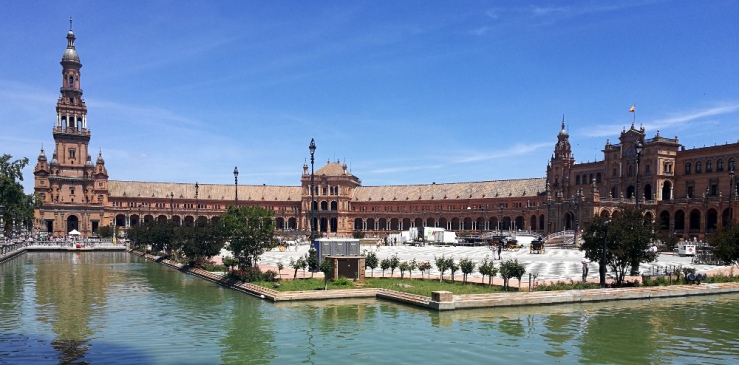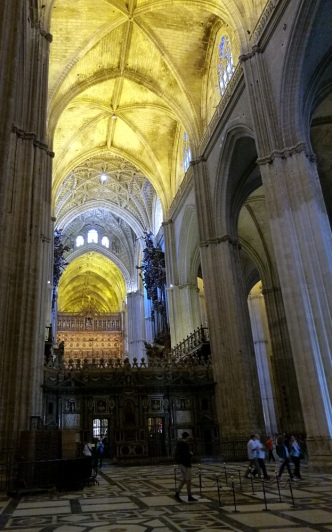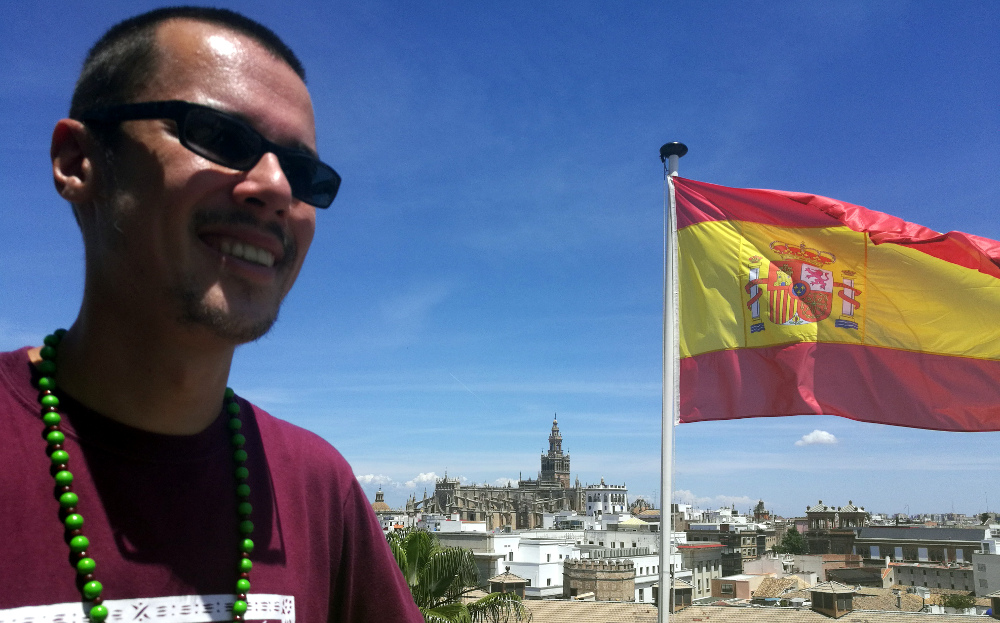I recently checked my personal travel statistics and the foreign country where I have stayed for the longest time is still India, but the country which I visited most often is Spain. And I am going there again, this time to the southern region of Andalucia. We take a cheap flight from Berlin Schönefeld Airport, recently rated the worst airport in the world. Air travel from Berlin always involves time travel backwards and a lot of patience, but if you don’t expect much, it is not that terrible. Arriving in Seville there is a nice airport bus.

The first evening we stroll a bit through the city center and Seville immediately makes a lovely and urban impression. I am going to love it here. One of the first things we do is going up the futuristic structure called Metropol Parasol or the Setas (mushrooms) which offers a beautiful view over the city. The old town and city center is really large, one of the largest in Europe. And to anticipate my overall impression of Seville: Yes, it is indeed a fancy European city, putting it in the same league as Rome, Paris, Barcelona, Vienna, and Prague.
Our hotel has a nice location. It is close to spots for restaurants and bars which are no tourist traps like the expensive ones in the historical center. One of these local spots is called Alameda, a mix between a street, a square, and a pedestrian zone. It becomes really alive at night. The name Alameda reminds me of the main road in Santiago in Chile. And there are indeed other things which evoke associations with South America. The street life makes me think of Mendoza in Argentina. And the Andalucian Spanish sounds strangely familiar. No surprise as it is very close to the variety spoken in many South American countries like Chile or Argentina. So I don’t need to bother with Standard Spanish much, although I have to say that Andalucian Spanish is not the easiest dialect to understand as all kinds of consonants are swallowed.

The next day we dive deep into the center and the history of the city. So many sights to see and things to explore. We have got to make some choices and decide for the most iconic ones. Sadly we skip the Moorish Alcázar palace as the queues are just too long. But we are going inside the cathedral. Being one of the largest landmarks from the outside it is even more impressive from the inside. It is Sunday and a Catholic mass is in progress which we do not want to disturb. The singing, the music, and the sheer size of the building are just overwhelming. I really begin to wonder if it is even higher than St. Peter’s Cathedral in Rome. Actually it is not, but it comes close. One interesting detail is the tomb of Christopher Columbus in the Cathedral. After several journeys his remains have been brought here in 1898 and DNA tests verified their authenticity.
We continue walking through the city, having some Spanish churros with chocolate, a typical fried-dough pastry. One site we can visit for free is the Plaza de España, built in 1929. This site is one of the most iconic places in Seville which I personally strongly associate with the city. And there is another reason why it appears so familiar. It has been used as a location in the Star Wars II movie – Attack of the Clones. Princess Amidala walking with Anakin Skywalker in a city on the planet Naboo.

Further walking takes us to some almost tropical parks. The city is green. Green and blue, as the Jacaranda trees are in full blueish bloom. On the shores of the river Guadalquivir which flows through Seville, we climb up the Torre de Oro, the golden tower. This is where we have another beautiful view over Andalucia’s capital and the Spanish flag is blowing in the wind. My legs are tired. Tomorrow we are going to move on. And there is still so much I have not seen here. Seville is a city I would happily come back to one day.

Kürzlich habe ich mal meine persönliche Reisestatistik durchgesehen und das Land, in dem ich die meiste Zeit verbracht habe, ist nach Deutschland immer noch Indien. Allerdings ist Spanien das Land, das ich am häufigsten besucht habe. Und es geht wieder dorthin, dieses Mal nach Andalusien. Von Berlin-Schönefeld nehmen wir einen Billigflieger. Der Flughafen wurde kürzlich zum schlechtesten der Welt gekürt. Eine Flugreise von Berlin beinhaltet grundsätzlich eigentlich immer eine Zeitreise in die Vergangenheit und man sollte Geduld mitbringen, aber wenn die Erwartungen niedrig sind, ist es eigentlich gar nicht so schlimm. In Sevilla können wir gleich einen bequemen Flughafenbus ins Zentrum nutzen.
Am ersten Abend schlendern wir durchs Zentrum und Sevilla macht sofort einen liebenswerten und sehr urbanen Eindruck. Ich glaube, mir wird es hier gut gefallen. Zunächst klettern wir auf eine futuristische Struktur namens Metropol Parasol oder Setas (Pilze) genannt. Von dort aus hat man einen schönen Blick über die Stadt. Das Stadtzentrum wirkt enorm groß und ist tatsächlich eines der größten in Europa. Und um den Gesamteindruck schon mal vorweg zu nehmen: Sevilla ist wirklich eine schicke und stylische europäische Metropole, in einer Liga mit Städten wie Rom, Paris, Barcelona, Wien oder Prag.
Unser Hotel liegt in einer netten Gegend, nicht weit entfernt von Restaurants und Bars, die im Gegensatz zu jenen im Stadtzentrum keine bloßen Touristenfallen zu sein scheinen. Eine dieser Ecken nennt sich Alameda, eine Art Mischung aus Allee, Platz und Fußgängerzone. Am Abend wird es hier richtig lebhaft. Der Name Alameda erinnert mich an die große Hauptstraße in Santiago in Chile. Mich erinnert noch einiges mehr an Südamerika. Beim Straßenleben denke ich an meine Reise nach Mendoza in Argentinien. Und das andalusische Spanisch kommt mir seltsam vertraut vor. Eigentlich ist das auch keine Überraschung, denn es ist dem südamerikanischen Spanisch in Chile oder Argentinien recht ähnlich. So muss ich mir keine Mühe machen, Standardspanisch zu sprechen, allerdings gehört der andalusische Dialekt auch nicht zu den leichtesten Sprachvarietäten, da alle möglichen Konsonanten beim Sprechen verschluckt werden.

Am nächsten Tag tauchen wir tiefer ins Stadtzentrum und seine Geschichte ein. So viele Sehenswürdigkeiten – wir müssen uns entscheiden und halten uns an die markantesten. Den maurischen Alcázarpalast lassen wir leider aus, da die Schlange beim Eintritt einfach zu lang ist. Aber wir gehen in die Kathedrale. Schon von draußen dominiert das Gebäude das Stadtbild, aber von innen ist es noch viel beeindruckender. Es ist Sonntag und die Menschen besuchen die katholische Messe, die wir auch nicht weiter stören wollen. Der Gesang, die Orgelmusik und die schiere Höhe des Gebäudes sind nahezu überwältigend. Ich beginne mich zu fragen, ob die Kathedrale nicht höher als der Petersdom in Rom ist. Das ist sie nicht, aber viel fehlt nicht. Ein interessantes Detail ist die Grabstätte von Christoph Kolumbus, dessen Überreste hier 1898 nach jahrhundertelanger Irrfahrt in Sevilla bestattet wurden. Die Echtheit wurde durch DNA-Tests bestätigt.
Wir laufen weiter durch die Stadt und gönnen uns Churros mit Schokolade, ein typisch spanisches Fettgebäck. Der 1929 errichtete Plaza de España lässt sich kostenlos besichtigen. Diesen Platz und sein Erscheinungsbild verbinde ich persönlich stark mit Sevilla. Und es gibt noch ein Grund, warum er so vertraut erscheint. Er diente als Kulisse im Star Wars II Film Angriff der Klonkrieger. Prinzessin Amidala spaziert mit Anakin Skywalker durch eine Stadt auf dem Planeten Naboo.
Nebenan befindet sich ein fast tropisch anmutender Park. Die Stadt wirkt recht grün. Grün und blau, denn die Palisanderholzbäume befinden sich in voller blauer Blüte. Am Ufer des Flusses Guadalquivir, der die Stadt durchfließt, erklimmen wir den Torre de Oro, den goldenen Turm. Von dort aus hat man wiederum einen schönen Blick über Andalusiens Hauptstadt. Die spanische Flagge weht im Wind. Meine Beine zeigen Ermüdungserscheinungen. Morgen geht es weiter in den nächsten Ort und es gibt immer noch so viel, was wir hier nicht gesehen haben. Nach Sevilla könnte ich wirklich gerne noch einmal zurückkehren.

